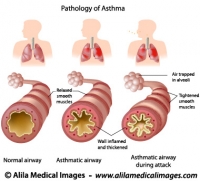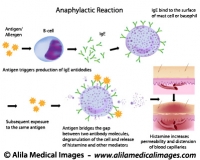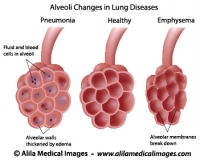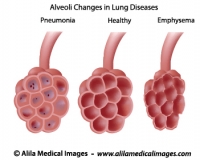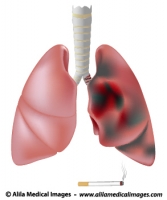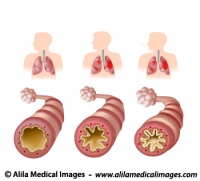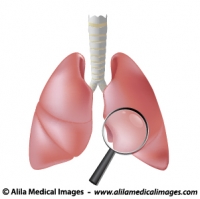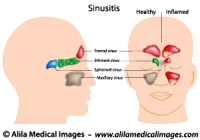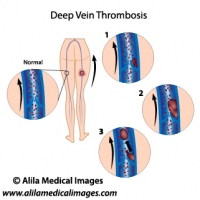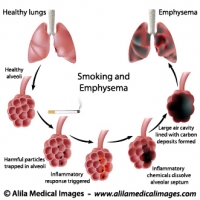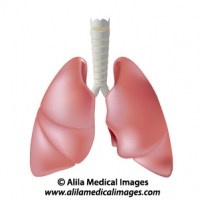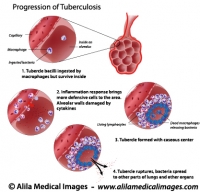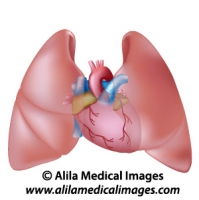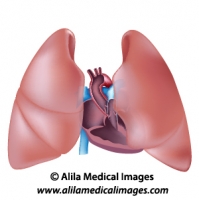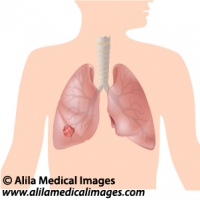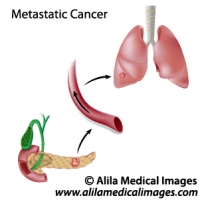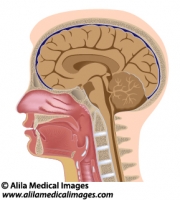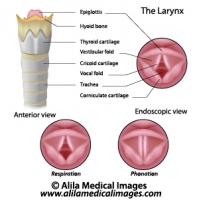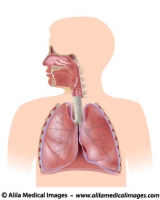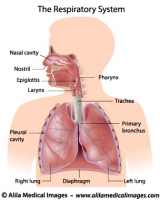The videos on this page can be downloaded upon purchase of a license on Alila Medical Media website. Click here!
Paranasal sinuses, or simply “sinuses” in common language, are air cavities in the bones of the skull. There are four pairs of sinuses (see Fig. 1, 2 and upper panel of Fig. 3):
– the maxillary sinuses are under the eyes, in the maxillary bones.
– the frontal sinuses are above the eyes, in the frontal bone.
– the ethmoid sinuses are between the nose and the eyes, in the ethmoid bone.
– the sphenoid sinuses are behind the nasal cavity, in the sphenoid bones.

Fig.1: The four pairs of sinuses. Red = frontal, green = ethmoid, blue = sphenoid, beige = maxillary. The right panel show normal sinuses on half of the head and inflamed sinuses on the other half. Click on image to see a larger version on Alila Medical Media website where the image is also available for licensing.
The sinuses are lined with respiratory epithelium producing mucus. The mucus drains into nasal cavity through small openings (Fig. 2 left panel, Fig. 3 upper panel). Impaired sinus drainage has been associated with inflammation of sinuses (sinusitis, see below).
Biological function of the sinuses remains unclear.
 .
.
Fig. 2: Front view of the sinuses (left panel) showing connections to the nasal cavity. Right panel shows mid-sagittal section of the head. Click on image to see a larger version on Alila Medical Media website where the image is also available for licensing.
Sinusitis or rhinosinusitis is inflammation of the paranasal sinuses (Fig. 1, right panel). This can be due to:
– allergy (allergic rhinitis): allergens such as pollen, pet dander,.. trigger overreaction of the mucosa of the nose and sinuses resulting in excess mucus, nasal congestion, sneezing and itching.
– infection: usually as a complication of an earlier viral infection of the nasal mucosa, pharynx or tonsils such as during a common cold. Impaired sinus drainage due to inflammation of nasal mucosa during a cold often leads to infection of the sinus itself. Cold-like symptoms plus headache and facial pain/pressure are common complaints.
– other conditions that cause blockage of sinus drainage: structural abnormality such as deviated nasal septum (Fig. 3); formation of nasal polyps (Fig. 4). When a sinus is blocked, fluid builds up making it a favorable environment for bacteria, viruses or fungi to grow and cause infection.

Fig. 3: Front view of the sinuses (upper panel) showing connections to the nasal cavity, also shown the nasal septum (light blue color). Lower panel shows deviated septum blocking drainage of the right maxillary sinus (your left). Click on image to see a larger version on Alila Medical Media website where the image is also available for licensing.
Fig. 4: Nasal polyps – overgrowths of nasal mucosa – block sinus drainage. Click on image to see a larger version on Alila Medical Media website where the image is also available for licensing.
Treatment depends on the cause of sinusitis:
– For viral infection : symptom relief medications such as nasal spray for irrigation and decongestion; other conservative treatment for common cold such as rest and drinking plenty of fluid.
– For bacterial infection: antibiotics may be prescribed.
– For allergy: intranasal corticosteroids are commonly used.
– For recurrent (chronic) sinusitis due to structural abnormalities or nasal polyps, nasal surgery may be recommended.








